回答反意疑问句的原则
- 格式:doc
- 大小:21.00 KB
- 文档页数:1
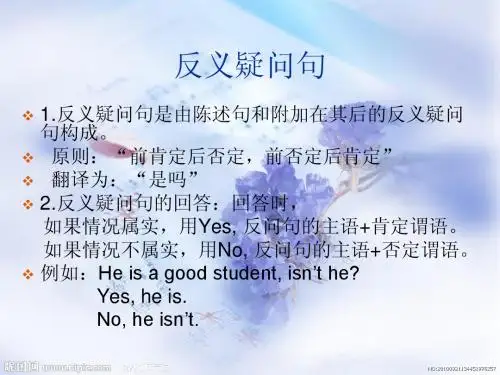
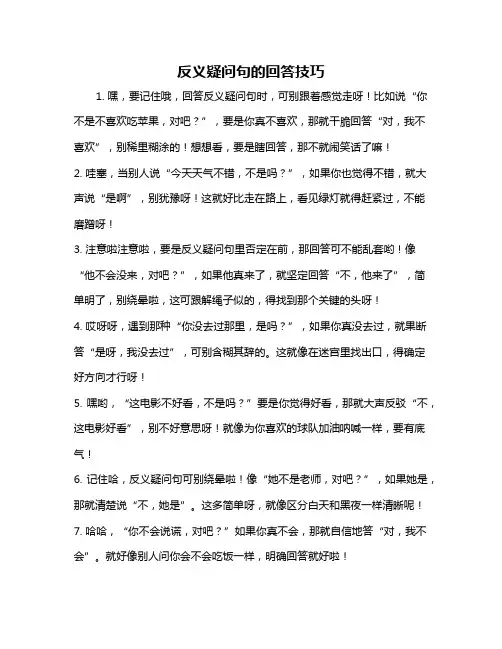
反义疑问句的回答技巧
1. 嘿,要记住哦,回答反义疑问句时,可别跟着感觉走呀!比如说“你不是不喜欢吃苹果,对吧?”,要是你真不喜欢,那就干脆回答“对,我不喜欢”,别稀里糊涂的!想想看,要是瞎回答,那不就闹笑话了嘛!
2. 哇塞,当别人说“今天天气不错,不是吗?”,如果你也觉得不错,就大声说“是啊”,别犹豫呀!这就好比走在路上,看见绿灯就得赶紧过,不能磨蹭呀!
3. 注意啦注意啦,要是反义疑问句里否定在前,那回答可不能乱套哟!像“他不会没来,对吧?”,如果他真来了,就坚定回答“不,他来了”,简单明了,别绕晕啦,这可跟解绳子似的,得找到那个关键的头呀!
4. 哎呀呀,遇到那种“你没去过那里,是吗?”,如果你真没去过,就果断答“是呀,我没去过”,可别含糊其辞的。
这就像在迷宫里找出口,得确定好方向才行呀!
5. 嘿哟,“这电影不好看,不是吗?”要是你觉得好看,那就大声反驳“不,这电影好看”,别不好意思呀!就像为你喜欢的球队加油呐喊一样,要有底气!
6. 记住哈,反义疑问句可别绕晕啦!像“她不是老师,对吧?”,如果她是,那就清楚说“不,她是”。
这多简单呀,就像区分白天和黑夜一样清晰呢!
7. 哈哈,“你不会说谎,对吧?”如果你真不会,那就自信地答“对,我不会”。
就好像别人问你会不会吃饭一样,明确回答就好啦!
我觉得呀,只要掌握了这些技巧,回答反义疑问句就不再是难事啦,关键是要用心去理解和体会哦!。
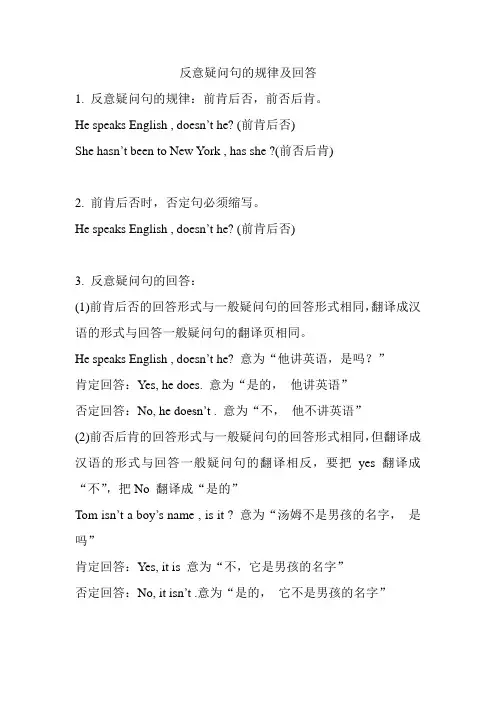
反意疑问句的规律及回答1.反意疑问句的规律:前肯后否,前否后肯。
He speaks English , doesn’t he? (前肯后否)She hasn’t been to New York , has she ?(前否后肯)2.前肯后否时,否定句必须缩写。
He speaks English , doesn’t he? (前肯后否)3.反意疑问句的回答:(1)前肯后否的回答形式与一般疑问句的回答形式相同,翻译成汉语的形式与回答一般疑问句的翻译页相同。
He speaks English , doesn’t he? 意为“他讲英语,是吗?”肯定回答:Yes, he does. 意为“是的,他讲英语”否定回答:No, he doesn’t . 意为“不,他不讲英语”(2)前否后肯的回答形式与一般疑问句的回答形式相同,但翻译成汉语的形式与回答一般疑问句的翻译相反,要把yes 翻译成“不”,把No 翻译成“是的”Tom isn’t a boy’s name , is it ? 意为“汤姆不是男孩的名字,是吗”肯定回答:Yes, it is 意为“不,它是男孩的名字”否定回答:No, it isn’t .意为“是的,它不是男孩的名字”反意疑问句的特殊情况1.前面的句子是I am …., 反意疑问句必须回答aren’t you?I am a student , aren’t you. 意为“我是一个学生,是吗”回答:Yes,I am. 是的,我是。
No, I’m not . 不,我不是。
2.当前句含有never,few, little ,nothing ,nobody ,hardly 等否定词时,用“前否后肯的规律。
”He knows little about Chinese history , does he?Yes , he does. 意为“不,他知道”No, he doesn’t意为“是的,他知道”3.前句含有否定前缀的词,依然把前句看成肯定句。
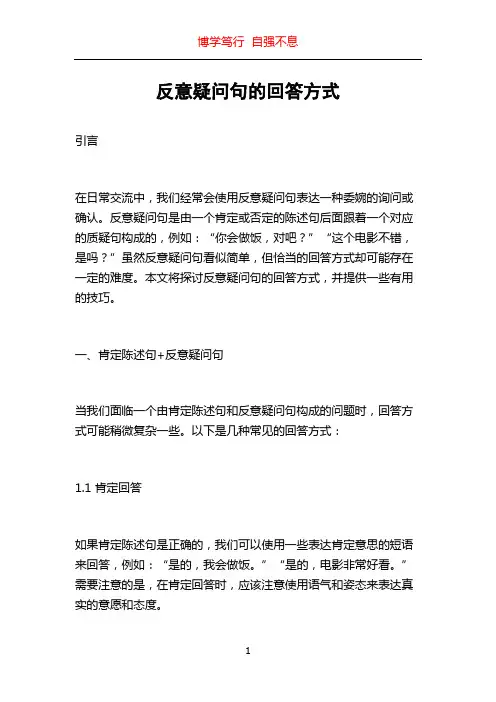
反意疑问句的回答方式引言在日常交流中,我们经常会使用反意疑问句表达一种委婉的询问或确认。
反意疑问句是由一个肯定或否定的陈述句后面跟着一个对应的质疑句构成的,例如:“你会做饭,对吧?”“这个电影不错,是吗?”虽然反意疑问句看似简单,但恰当的回答方式却可能存在一定的难度。
本文将探讨反意疑问句的回答方式,并提供一些有用的技巧。
一、肯定陈述句+反意疑问句当我们面临一个由肯定陈述句和反意疑问句构成的问题时,回答方式可能稍微复杂一些。
以下是几种常见的回答方式:1.1 肯定回答如果肯定陈述句是正确的,我们可以使用一些表达肯定意思的短语来回答,例如:“是的,我会做饭。
”“是的,电影非常好看。
”需要注意的是,在肯定回答时,应该注意使用语气和姿态来表达真实的意愿和态度。
1.2 否定回答如果肯定陈述句是错误的,我们可以直接否定反意疑问句,例如:“不,我不会做饭。
”“不,这个电影并不好看。
”需要注意的是,在否定回答时,也应该使用适当的语气和姿态来表达清晰的立场,并尽量避免给人造成困扰或不适的感觉。
1.3 陈述重复如果我们觉得肯定陈述句是正确的,但不确定对方的意图是否纯粹是询问,我们可以直接重复陈述句来回答,例如:“是的,我会做饭。
”或者简单地回答一个“会”或者“对”的肯定应答。
这样一来,我们既表达了自己的肯定意愿,又避免了过度回应对方的质疑。
二、否定陈述句+反意疑问句当我们面临一个由否定陈述句和反意疑问句构成的问题时,回答方式相对简单一些。
以下是几种常见的回答方式:2.1 肯定回答如果否定陈述句是错误的,我们可以直接肯定反意疑问句,例如:“是的,我不会做饭。
”“是的,这个电影并不好看。
”需要注意的是,在肯定回答时,仍然需要使用恰当的语气和礼貌态度,以免给人带来不必要的烦恼或误解。
2.2 否定回答如果否定陈述句是正确的,我们可以使用一些否定意思的短语来回答,例如:“不,我不会做饭。
”“不,这个电影并不好看。
”同样,需要注意在回答时传达清晰的立场,同时保持礼貌和尊重。
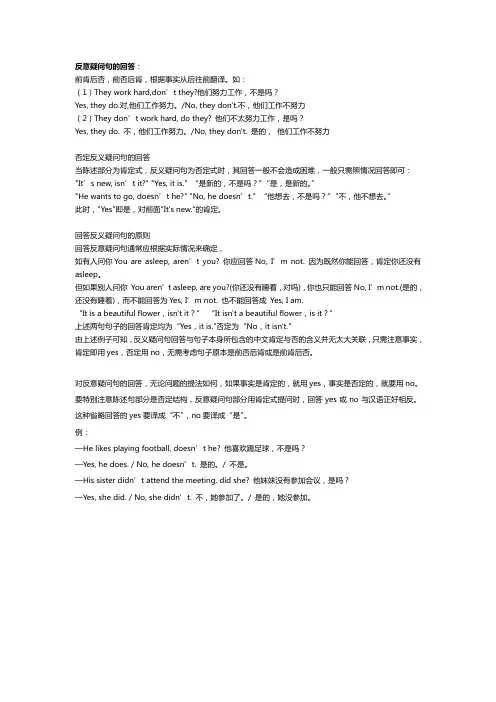
反意疑问句的回答:前肯后否,前否后肯,根据事实从后往前翻译。
如:(1)They work hard,don’t they?他们努力工作,不是吗?Yes, they do.对,他们工作努力。
/No, they don't.不,他们工作不努力(2)They don’t work hard, do they? 他们不太努力工作,是吗?Yes, they do. 不,他们工作努力。
/No, they don't. 是的,他们工作不努力否定反义疑问句的回答当陈述部分为肯定式,反义疑问句为否定式时,其回答一般不会造成困难,一般只需照情况回答即可:"It’s new, isn’t it?" "Yes, it is." “是新的,不是吗?”“是,是新的。
”"He wants to go, doesn’t he?" "No, he doesn’t." “他想去,不是吗?”“不,他不想去。
”此时,"Yes"即是,对前面"It's new."的肯定。
回答反义疑问句的原则回答反意疑问句通常应根据实际情况来确定,如有人问你You are asleep, aren’t you? 你应回答No, I’m not. 因为既然你能回答,肯定你还没有asleep。
但如果别人问你You aren’t asleep, are you?(你还没有睡着,对吗),你也只能回答No, I’m not.(是的,还没有睡着),而不能回答为Yes, I’m not. 也不能回答成Yes, I am.“It is a beautiful flower,isn't it?”“It isn't a beautiful flower,is it?”上述两句句子的回答肯定均为“Yes,it is."否定为“No,it isn't."由上述例子可知,反义疑问句回答与句子本身所包含的中文肯定与否的含义并无太大关联,只需注意事实,肯定即用yes,否定用no,无需考虑句子原本是前否后肯或是前肯后否。
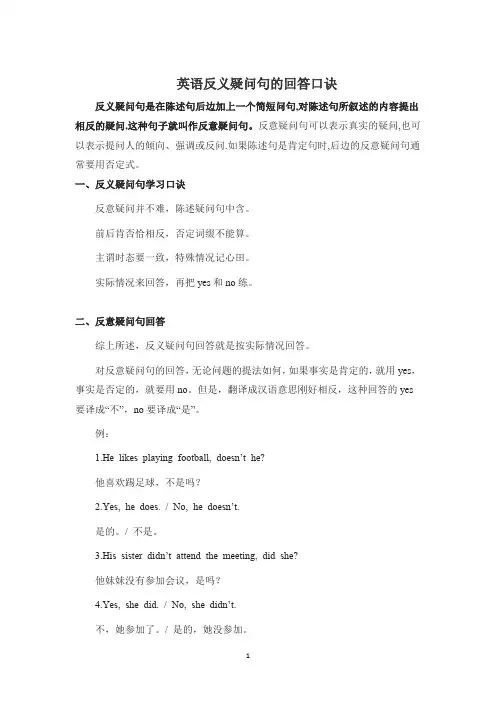
英语反义疑问句的回答口诀
反义疑问句是在陈述句后边加上一个简短问句,对陈述句所叙述的内容提出相反的疑问,这种句子就叫作反意疑问句。
反意疑问句可以表示真实的疑问,也可以表示提问人的倾向、强调或反问.如果陈述句是肯定句时,后边的反意疑问句通常要用否定式。
一、反义疑问句学习口诀
反意疑问并不难,陈述疑问句中含。
前后肯否恰相反,否定词缀不能算。
主谓时态要一致,特殊情况记心田。
实际情况来回答,再把yes和no练。
二、反意疑问句回答
综上所述,反义疑问句回答就是按实际情况回答。
对反意疑问句的回答,无论问题的提法如何,如果事实是肯定的,就用yes,事实是否定的,就要用no。
但是,翻译成汉语意思刚好相反,这种回答的yes 要译成“不”,no要译成“是”。
例:
1.He likes playing football, doesn’t he?
他喜欢踢足球,不是吗?
2.Yes, he does. / No, he doesn’t.
是的。
/ 不是。
3.His sister didn’t attend the meeting, did she?
他妹妹没有参加会议,是吗?
4.Y es, she did. / No, she didn’t.
不,她参加了。
/ 是的,她没参加。
1。
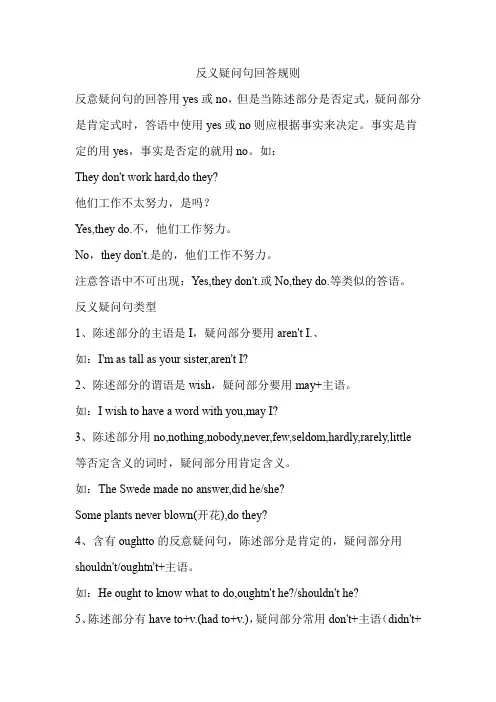
反义疑问句回答规则反意疑问句的回答用yes或no,但是当陈述部分是否定式,疑问部分是肯定式时,答语中使用yes或no则应根据事实来决定。
事实是肯定的用yes,事实是否定的就用no。
如:They don't work hard,do they?他们工作不太努力,是吗?Yes,they do.不,他们工作努力。
No,they don't.是的,他们工作不努力。
注意答语中不可出现:Yes,they don't.或No,they do.等类似的答语。
反义疑问句类型1、陈述部分的主语是I,疑问部分要用aren't I.、如:I'm as tall as your sister,aren't I?2、陈述部分的谓语是wish,疑问部分要用may+主语。
如:I wish to have a word with you,may I?3、陈述部分用no,nothing,nobody,never,few,seldom,hardly,rarely,little 等否定含义的词时,疑问部分用肯定含义。
如:The Swede made no answer,did he/she?Some plants never blown(开花),do they?4、含有oughtto的反意疑问句,陈述部分是肯定的,疑问部分用shouldn't/oughtn't+主语。
如:He ought to know what to do,oughtn't he?/shouldn't he?5、陈述部分有have to+v.(had to+v.),疑问部分常用don't+主语(didn't+主语)。
如:We have to get there at eight tomorrow,don't we?6、陈述部分的谓语是usedto时,疑问部分用didn't+主语或usedn't+主语。
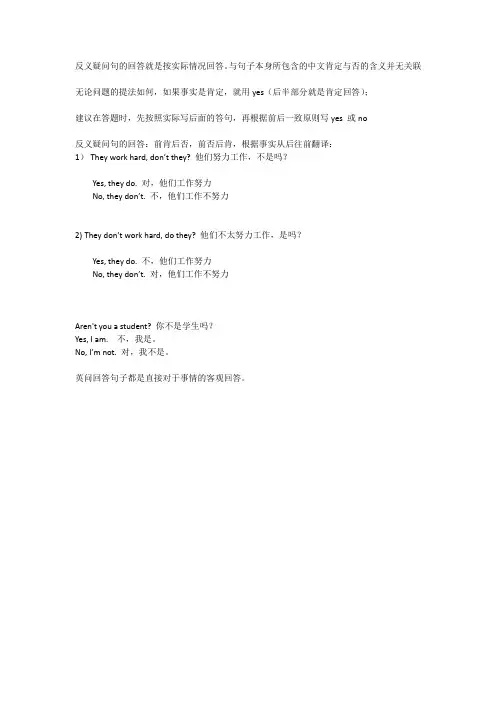
反义疑问句的回答就是按实际情况回答。
与句子本身所包含的中文肯定与否的含义并无关联无论问题的提法如何,如果事实是肯定,就用yes(后半部分就是肯定回答);
建议在答题时,先按照实际写后面的答句,再根据前后一致原则写yes 或no
反义疑问句的回答:前肯后否,前否后肯,根据事实从后往前翻译:
1)They work hard, don’t they? 他们努力工作,不是吗?
Yes, they do. 对,他们工作努力
No, they don’t. 不,他们工作不努力
2)They don’t work hard, do they? 他们不太努力工作,是吗?
Yes, they do. 不,他们工作努力
No, they don’t. 对,他们工作不努力
Aren't you a student? 你不是学生吗?
Yes, I am. 不,我是。
No, I’m not. 对,我不是。
英问回答句子都是直接对于事情的客观回答。
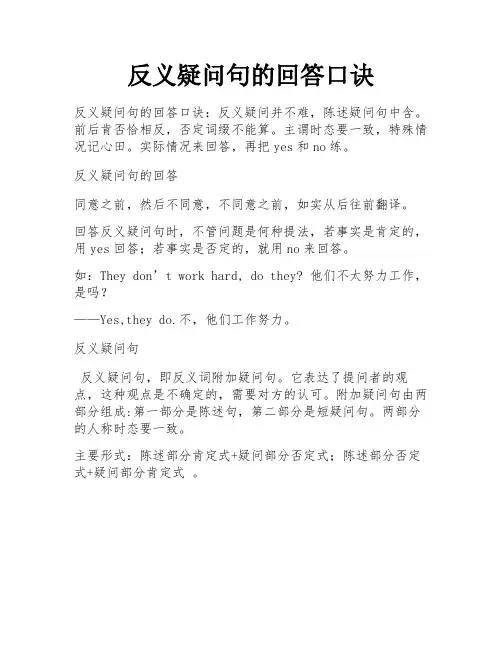
反义疑问句的回答口诀
反义疑问句的回答口诀:反义疑问并不难,陈述疑问句中含。
前后肯否恰相反,否定词缀不能算。
主谓时态要一致,特殊情况记心田。
实际情况来回答,再把yes和no练。
反义疑问句的回答
同意之前,然后不同意,不同意之前,如实从后往前翻译。
回答反义疑问句时,不管问题是何种提法,若事实是肯定的,用yes回答;若事实是否定的,就用no来回答。
如:They don’t work hard, do they? 他们不太努力工作,是吗?
——Yes,they do.不,他们工作努力。
反义疑问句
反义疑问句,即反义词附加疑问句。
它表达了提问者的观点,这种观点是不确定的,需要对方的认可。
附加疑问句由两部分组成:第一部分是陈述句,第二部分是短疑问句。
两部分的人称时态要一致。
主要形式:陈述部分肯定式+疑问部分否定式;陈述部分否定式+疑问部分肯定式。
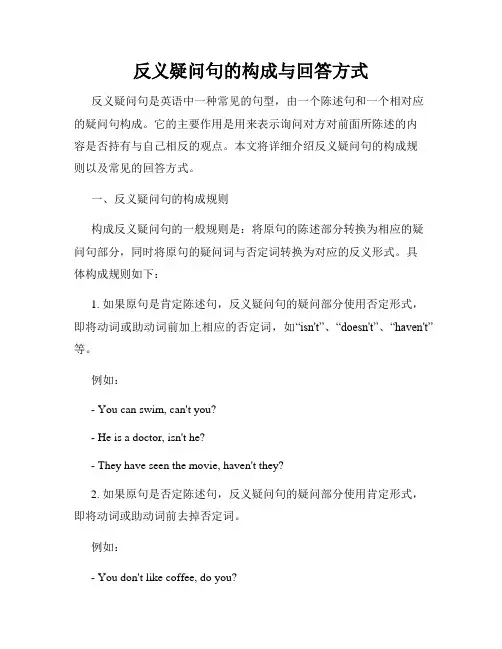
反义疑问句的构成与回答方式反义疑问句是英语中一种常见的句型,由一个陈述句和一个相对应的疑问句构成。
它的主要作用是用来表示询问对方对前面所陈述的内容是否持有与自己相反的观点。
本文将详细介绍反义疑问句的构成规则以及常见的回答方式。
一、反义疑问句的构成规则构成反义疑问句的一般规则是:将原句的陈述部分转换为相应的疑问句部分,同时将原句的疑问词与否定词转换为对应的反义形式。
具体构成规则如下:1. 如果原句是肯定陈述句,反义疑问句的疑问部分使用否定形式,即将动词或助动词前加上相应的否定词,如“isn't”、“doesn't”、“haven't”等。
例如:- You can swim, can't you?- He is a doctor, isn't he?- They have seen the movie, haven't they?2. 如果原句是否定陈述句,反义疑问句的疑问部分使用肯定形式,即将动词或助动词前去掉否定词。
例如:- You don't like coffee, do you?- He isn't coming, is he?- They haven't finished their homework, have they?需要注意的是,在构成反义疑问句时,陈述部分与疑问部分的人称和数要保持一致。
二、回答反义疑问句的方式回答反义疑问句时,可以使用肯定回答或否定回答。
常见的回答方式有以下几种:1. 肯定回答:对于反义疑问句的肯定回答,即表示对前面所陈述的内容持有与自己相同的观点。
在使用肯定回答时,需要将疑问句部分的形式与陈述句部分保持一致。
例如:- You can swim, can't you?- Yes, I can.- He is a doctor, isn't he?- Yes, he is.- They have seen the movie, haven't they?- Yes, they have.2. 否定回答:对于反义疑问句的否定回答,即表示对前面所陈述的内容持有与自己相反的观点。
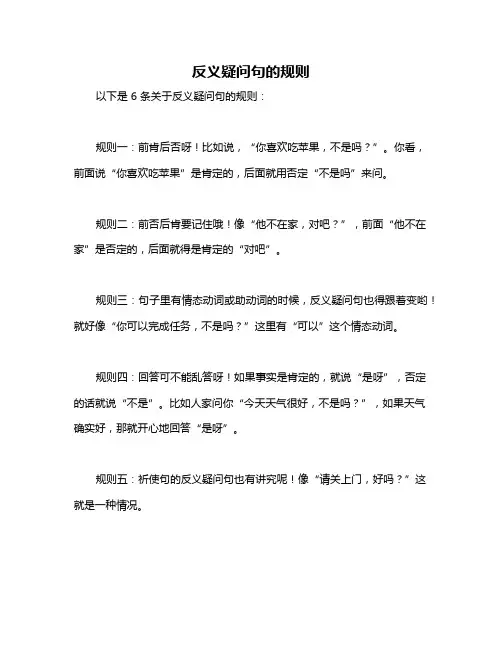
反义疑问句的规则
以下是 6 条关于反义疑问句的规则:
规则一:前肯后否呀!比如说,“你喜欢吃苹果,不是吗?”。
你看,前面说“你喜欢吃苹果”是肯定的,后面就用否定“不是吗”来问。
规则二:前否后肯要记住哦!像“他不在家,对吧?”,前面“他不在家”是否定的,后面就得是肯定的“对吧”。
规则三:句子里有情态动词或助动词的时候,反义疑问句也得跟着变哟!就好像“你可以完成任务,不是吗?”这里有“可以”这个情态动词。
规则四:回答可不能乱答呀!如果事实是肯定的,就说“是呀”,否定的话就说“不是”。
比如人家问你“今天天气很好,不是吗?”,如果天气确实好,那就开心地回答“是呀”。
规则五:祈使句的反义疑问句也有讲究呢!像“请关上门,好吗?”这就是一种情况。
规则六:否定前移的句子要注意后面的反义疑问句怎么问哟!“我觉得你不对,是吗?”就是这样的例子。
我觉得反义疑问句挺有意思的呀,学会了这些规则,咱就能更好地用它啦!。
反义疑问句的回答
反义疑问句的回答:前肯后否,前否后肯,根据事实从后往前翻译。
回答反意疑问句时,不管问题是何种提法,若事实是肯定的,用yes回答;若事实是否定的,就用no来回答。
反意疑问句的回答
前肯后否,前否后肯,根据事实从后往前翻译。
(1)They work hard,don’t they?他们努力工作,不是吗?
Yes, they do.对,他们工作努力。
/No, they don't.不,他们工作不努力。
(2)They don’t work hard, do they? 他们不太努力工作,是吗?
Yes, they do. 不,他们工作努力。
/No, they don't. 是的,他们工作不努力。
否定反义疑问句的回答:当陈述部分为肯定式,反义疑问句为否定式时,其回答一般不会造成困难,一般只需照情况回答即可:
"It’s new, isn’t it?" "Yes, it is." “是新的,不是吗?”“是,是新的。
”
"He wants to go, doesn’t he?" "No, he doesn’t." “他想去,不是吗?”“不,他不想去。
”
此时,“Yes”即是对前面“It's new.”的肯定。
反义疑问句的回答规则和用法举例说明第一篇嘿,亲爱的朋友们!今天咱们来聊聊反义疑问句哈。
啥是反义疑问句呢?其实就是那种前面说一句话,后面再跟个小尾巴问句的句子。
比如说“你今天很开心,不是吗?” 这就是个反义疑问句啦。
那回答反义疑问句可有讲究哦!如果事实是肯定的,那咱就回答“yes”;要是事实是否定的,就得回答“no”。
可别被问句的形式给弄晕了。
举个例子哈,“你喜欢冰淇淋,不是吗?” 如果你真喜欢,那就得大大方方说“Yes, I do.” 要是不喜欢呢,就说“No, I don't.”再比如“天气不好,对吧?” 如果天气确实不好,那回答“Yes, it is.” 要是天气还不错,那就回答“No, it isn't.”这里要注意啦,回答的时候,别管问句是肯定还是否定,只看事实就行。
有时候反义疑问句还能用来加强语气呢。
像“你肯定会来参加聚会的,不是吗?” 就是希望你能给个肯定的答复。
好啦,这就是反义疑问句的回答规则,是不是挺简单的?大家多练练就能掌握啦!第二篇亲爱的小伙伴们,咱们接着唠唠反义疑问句。
先来说说回答反义疑问句的规则哈。
别想得太复杂,就看实际情况咋样。
比如说“他没完成作业,是吗?”如果他真没完成,那就回答“No, he didn't.” 要是完成了,就回答“Yes, he did.”再举个例子,“这道题不难,对吧?” 要是觉得难,就说“No, it is.” 要是觉得不难,那就是“Yes, it isn't.” 哈哈,是不是有点绕?其实多琢磨琢磨就清楚啦。
还有哦,反义疑问句有时候能让对话更有趣呢。
像“你不会迟到的,对不对?” 这其实是在期待你准时到达。
比如说“她很漂亮,不是吗?” 要是你也这么觉得,就回答“Yes, she is.” 不这么认为,就说“No, she isn't.”反义疑问句在日常生活中可常用啦,学会了回答,交流就更顺畅咯。
怎么样,小伙伴们,是不是对反义疑问句的回答心里有点数啦?多和朋友用用,很快就能熟练啦!。
反义疑问句回答规则和例子
1. 嘿,你知道吗,如果反义疑问句前面是肯定句,后面就得接否定的疑问啦!就像“你今天吃饭了,不是吗?”这多简单呀!
2. 哇哦,要是反义疑问句前面是否定句呢,那后面当然就要是肯定的疑问咯!比如说“你没完成作业,对吧?”,是不是一下子就懂啦!
3. 你想想看呀,如果别人问你“今天天气不错,不是吗?”,你要是觉得天气好,那当然得回答“是呀”,要是觉得不好,就说“不是”呀,这有啥难的呢!
4. 哎呀,像“他会弹钢琴,不会吗?”这样的反义疑问句,回答起来也很容易呀,如果他确实会弹,那就是“会呀”,不会弹就是“不会”呢!
5. 嘿嘿,“你喜欢这部电影,对吗?”这种时候,如果你喜欢,就大胆说“对”,不喜欢就说“不对”,多直接呀!
6. 你瞅瞅,“她跑得很快,不是吗?”要是她真的跑得很快,那咱就果断答“是”呀,不要犹豫哦!
总之,反义疑问句回答超简单的呀,就是根据事实来,别想得太复杂啦!。
回答反义疑问句的原则店铺:在回答反意疑问句的时候我们需要遵循哪些原则才有用呢?下面我们一起看看这篇《回答反义疑问句的原则》。
回答反意疑问句通常应根据实际情况来确定,如有人问你You are asleep, aren’t you? 你应回答No, I’m not. 因为既然你能回答,肯定你还没有asleep。
但如果别人问你You aren’t asleep, are you?(你还没有睡着,对吗),你也只能回答No, I’m not.(是的,还没有睡着),而不能回答为Yes, I’m not. 也不能回答成 Yes, I am.“It is a beautiful flower,isn't it?” “It isn't a beautiful flower,is it?”上述两句句子的回答肯定均为“Yes,it is."否定为“No,it isn't."由上述例子可知,反义疑问句回答与句子本身所包含的中文肯定与否的含义并无太大关联,只需注意事实,肯定即用yes,否定用no,无需考虑句子原本是前否后肯或是前肯后否。
建议在答题时,先按照实际写后面的答句,再根据前后一致原则写Yes或No。
口诀反意疑问并不难,陈述疑问句中含。
前后肯否恰相反,否定词缀不能算。
主谓时态要一致,特殊情况记心田。
实际情况来回答,再把yes和no练。
综上所述,反义疑问句回答就是按实际情况回答。
对反意疑问句的回答,无论问题的提法如何,如果事实是肯定的,就用yes,事实是否定的,就要用no。
但是,翻译成汉语意思刚好相反,这种回答的yes要译成“不”,no要译成“是”。
公众号:英语语法教程。
反义疑问句前肯后否回答规则1. 反义疑问句的基本概念说到反义疑问句,大家可能会觉得有点儿抽象。
简单来说,就是你在说一个肯定句的时候,后面跟着一个否定的问句。
比如,“你喜欢吃水果,是吧?”这里的“是吧”就属于反义疑问句。
其实,它就像是给对方一个机会,看看他有没有什么不同的看法。
挺有意思的,对吧?不过,要注意的是,当你用反义疑问句的时候,前面的陈述必须是肯定的,后面的问句才会是否定的,反之亦然。
否则可就尴尬了!1.1 反义疑问句的用法我们在日常生活中,经常会用到这种句型。
比如,想让朋友确认一件事,你可以说:“今天的天气真不错,不是吗?”这时候,你其实是在引导对方同意你的观点。
这个句子既轻松又随意,像是在跟好朋友聊天。
想象一下,坐在阳光明媚的公园里,边吃冰淇淋边聊天气,简直是享受啊。
1.2 反义疑问句的例子再来个例子,“你也觉得这部电影很精彩,对吧?”这时候,听到的人可能会点头,心里想着,“没错呀,真是太好看了!”这就是反义疑问句的魅力所在,它让人感觉亲切,同时又能引导话题。
甚至在聊天的时候,还能让气氛更加轻松愉快。
你看,就像我们之间的互动,轻松自然,不需要太多压力。
2. 反义疑问句的回答规则当然,光会问可不够,咱们还得学会怎么回答。
一般来说,肯定的句子后面跟着否定的回答,反之亦然。
比如,如果我问:“你今天吃了早餐,是吧?”你可以说:“是的,我吃了。
”或者反过来,“没错,我没吃。
”这样的话,你的回答就跟我的提问形成了鲜明的对比,给人一种耳目一新的感觉。
2.1 如何优雅地回答不过,回答的时候也可以加点花样。
比如,有人问:“你喜欢旅行,对吧?”你可以笑着说:“当然喜欢,我可是个旅行狂呢!”这样就不仅回答了问题,还顺便透露了你的个性,显得特别有趣。
对话的过程就像是在舞蹈,每个人都有自己的节奏,跳得愉快才是最重要的。
2.2 注意事项不过,有些情况下可能会让人困惑。
例如,“你没看过这部剧,是吧?”如果你是看过的,就不能简单回答“是的”。
反义疑问句答语的规则和用法
1. 嘿,咱得知道,当反义疑问句的陈述部分是肯定时,那回答可就得注意啦!比如“你喜欢冰淇淋,不是吗?”如果你真喜欢,那就要坚定地说“是呀,我喜欢”,可别含糊!
2. 哎呀,如果陈述部分是否定的,那回答也要对应好哦!像“你不吃辣,对不?”要是你真不吃辣,那就得果断答“对,我不吃”。
3. 反义疑问句回答的时候,要根据实际情况来呀,可不能乱答!比如人家问“今天天气不错,对吧?”天气确实好,那就开心地答“没错呀,天气很好”。
4. 你们想想,要是问“她不是老师,是不是?”如果她确实不是老师,就得明确答“不是,她不是”。
5. 咱要记住,回答的一致性很重要呢!像“你会做饭,难道不是吗?”会做就答“是呀,我会做饭”,别犹豫。
6. 要是碰到“这电影不精彩,对吧?”而电影真的不精彩,那就要坦然说“对,电影不精彩”。
7. 当反义疑问句来了,心里得有谱呀!就像“你没去过那里,是吗?”没去过就大大方方说“嗯,我没去过”。
8. 反义疑问句回答不难的呀,举个例子“他很幽默,不是吗?”觉得他幽默就答“是呀,他很幽默”。
9. 所以说呀,掌握反义疑问句答语的规则和用法其实很简单呢!大家多练习练习,就会发现真的超容易!
我的观点结论就是:只要理解清楚、多加练习,搞定反义疑问句答语根本不是事儿!。
反意疑问句的回答用yes, no,但是,回答翻译相反,回答要按事实。
如:
They don’t work hard, do they? 他们不太努力工作,是吗?
Yes, they do. 不,他们工作努力。
/No, they don't. 对,他们工
作不努力
肯定反义疑问句的回答
当陈述部分为否定式,反意疑问句为肯定式时,其回答往往与汉语不
一致,需特别引起注意:
"It isn’t cheap, is it?" "Yes, it is." “它不便宜吧?”“不,很便宜。
”
"He doesn’t love her, does he?" "No, he doesn’t."“他不爱她,是吗?”“是的,他不爱她。
”
此时,"Yes"即不,对前面"It isn't cheap."的否定。
否定反意疑问句的回答
当陈述部分为肯定式,反义疑问句为否定式时,其回答一般不会造成
困难,一般只需照情况回答即可:
"It’s new, isn’t it?" "Yes, it is." “是新的,对吗?”“对,是新的。
”
"He wants to go, doesn’t he?" "No, he doesn’t." “他想去,
对吗?”“不,他不想去。
”
此时,"Yes"即是,对前面"It's new."的肯定。
回答反意疑问句的原则
回答反意疑问句通常应根据实际情况来确定,如有人问你You are asleep, aren’t you? 你应回答No, I’m not. 因为既然你能回答,肯定
你还没有asleep。
但如果别人问你You aren’t asleep, are you?(你还
没有睡着,对吗),你也只能回答No, I’m not.(是的,还没有睡着),而
不能回答为Yes, I’m not. 也不能回答成 Yes, I am.
“It is a beautiful flower,isn't it?” “It isn't a beautiful flower,is it?”
上述两句句子的回答肯定均为“Yes,it is."否定为“No,it isn't."
由上述例子可知,反义疑问句回答与句子本身所包含的中文肯定与否
的含义并无太大关联,只需注意事实,肯定即用yes,否定用no,无需考
虑句子原本是前否后肯或是前肯后否。